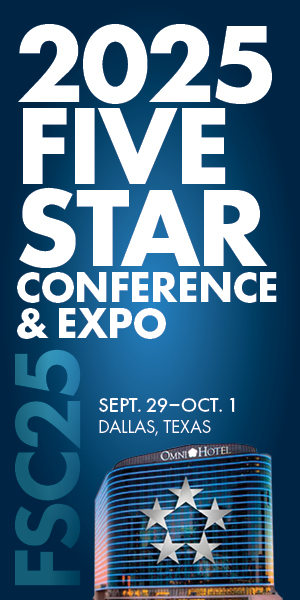“There are not more than five musical notes, yet the combinations of these five give rise to more melodies than can ever be heard. There are not more than five primary colors, yet in combination, they produce more hues than can ever be seen. There are not more than five cardinal tastes, yet combinations of them yield more flavors than can ever be tasted.”—Sun Tzu
This piece originally appeared in the May 2024 edition of MortgagePoint magazine, online now.
Sun Tzu, the ancient Chinese military general, strategist, philosopher, and writer might not be the person you would expect to turn to for insights into the topic of diversity, equity, and inclusion (DEI, sometimes referred to alternatively as D&I/diversity & inclusion). Nevertheless, the quote above succinctly gets at the heart of many of the arguments made by modern proponents of DEI practices in business, including The Five Star Institute’s own American Mortgage Diversity Council (AMDC).
Sharifa A. Anderson, SVP and Chief Diversity and Inclusion Officer at Fannie Mae, told MortgagePoint, “We are navigating a moment of heightened backlash against D&I, with D&I-related litigation on the rise and the number of states introducing and passing legislation that limits D&I initiatives growing. Organizations committed to D&I have to reclaim the confusing narratives about what D&I is and is not. In this moment, clarity around the business case for D&I and what we are trying to accomplish is critical. D&I has always meant equal opportunity and inclusion at Fannie Mae, and our commitment to D&I, like many other companies, remains strong. For us, D&I isn’t just the right thing to do, it’s the smart thing to do.”
For this month’s cover story, MortgagePoint connected with DEI subject-matter experts from Fannie Mae, the financial services law firm of McCalla Raymer Leibert Pierce, Precedent Management, and U.S. Bank. These experts address why D&I/DEI strategies remain a focus as both the American landscape of homeowners and the American workforce continue to diversify and undergo significant demographic shifts.
Mapping the Landscape of DEI/D&I
DEI organizational structures are designed to encourage the equitable treatment and full participation of all persons, particularly those who have traditionally been underrepresented or susceptible to discrimination based on identity or disability. According to the U.S. Bureau of Labor Statistics (BLS), no more than 20% of professionals in the finance industry identify as non-white.
According to the 2024 Diversity and Inclusion Global Strategic Business Report, the global D&I market—which was anticipated to be worth $10.9 billion in 2023—is projected to grow at a compound annual growth rate of 10.6% between 2023 and 2030.
Overall, whites make up 77% of the U.S. labor force, while Blacks and Asians accounted for an additional 13% and 7%, respectively. American Indians and Alaska Natives made up 1% of the labor force, while Native Hawaiians and other Pacific Islanders accounted for over half. People of two or more races accounted for 2% of the labor force.
Organizations across the mortgage industry continue to develop strategies to promote equality, build a broader system of sustainable American homeownership, and leverage the benefits of diverse teams and viewpoints, as aided by groups such as the AMDC.
Fannie Mae’s recent work on these fronts has included implementing tools such as using text-scanning software to identify prohibited and subjective language in the appraisal space and utilizing technology to improve underwriting.
“While we’re continuing to identify and expand upon how we can leverage technology in a safe and sound manner—we’ve already seen the benefits,” Anderson said. “From September 2021 through March 2024, approximately 6,300 applications have benefitted from positive rent payment history (PRPH)—meaning they were Approve-Eligible when otherwise they might not have been. Of the mortgage applications that benefitted from PRPH, some 51.3% of the borrowers identified as minority and 40.6% identified specifically as Black or Latino/Hispanic.”
D&I actions must be “supported and guided” by a wide range of data and analytics, according to Anderson. This data influences a strategic course of action and attempts to reduce prejudice. She expressed that it also contributes to a better understanding of the impact of those efforts, both in terms of progress and opportunity.
Erika Garcia, COO of Precedent Management and member of the AMDC, emphasized the importance of maintaining a strong commitment to DEI, especially during economic uncertainty. She highlighted the industry’s need to foster inclusive cultures where diverse perspectives are valued and respected. Further, she acknowledged the progress made in including women and people from ethnic cultures in leadership positions but recognized the need for further change.
“Commitment to Diversity, Equity, and Inclusion remains crucial, especially in the light of recent challenges or cutbacks against the tougher power organizations that may face constraints or setbacks,” Garcia said. “The importance of fostering diversity and inclusive environments remains a fundamental aspect of building equitable workplaces and societies.”
Maintaining a strong dedication to DEI might sometimes be challenging, but Garcia and other experts told MortgagePoint it is essential for the full success and growth of many organizations. Among other aspects, addressing systemic disparities, encouraging diversity and leadership, and cultivating an inclusive culture can help drive innovation, attract, and retain talent, and build organizational resilience and sustainability.
“The landscape of DEI has undergone significant changes in recent years, with ongoing shifts continuing to shape the way organizations approach and prioritize these efforts,” Garcia said. “Some notable changes and ongoing trends include … increased awareness and scrutiny, legislative and regulatory changes, intersectionality, and focus on inclusive culture.” She encouraged professionals in leadership roles or working within the DEI/D&I space to “step up and be the change.”
“Intersectionality” is defined by Oxford Languages as “the interconnected nature of social categorizations such as race, class, and gender as they apply to a given individual or group, regarded as creating overlapping and interdependent systems of discrimination or disadvantage.”
Garcia added that because underrepresented communities may experience injustices and problems in the workplace, potential biases may arise that manifest in processes and daily interactions—resulting in fewer opportunities, support, and resources to help individuals succeed.
Fannie Mae’s Anderson told MortgagePoint that “D&I needs to be integrated into all company processes.”
Fannie Mae has a history of recognition for its diversity and inclusion efforts, being named a “Best Place to Work for Disability Inclusion” by the American Association of People with Disabilities last year, receiving a top score on the 2023 Disability Equality Index.
Anderson continued, “Broadly defined, diversity refers to all the characteristics that make individuals different—the invisible and visible. Inclusion refers to our work to welcome and embrace diversity and leverage that diversity to improve business outcomes.”
How Companies Are Implementing DEI/D&I
On the topic of intersectionality, Precedent’s Garcia explained that there is a “greater recognition of the intersecting nature of different identities and experiences within the business world today.” These shifts could eventually lead to a more nuanced understanding of DEI. Organizations are increasingly addressing how health factors such as ethnicity, gender, sexual orientation, disability, and socioeconomic status impact people’s job experiences. Garcia has brainstormed and organized efforts herself to further promote these ideas.
Her efforts include:
- Implementing quarterly, optional DEI meetings for employees to foster open dialogue and learning.
- Speaking to employees resistant to DEI efforts, emphasizing respect for different opinions.
- Ensuring strong leadership commitment through time dedication and active championing of inclusive practices despite budget constraints.
- Working on improving leadership commitment to DEI efforts through more time and budget allocation.
- Launching a mentorship program that promotes diversity.
The quarterly meetings provide team members with insights into the nature of intersectionality and why it is important to Garcia and her firm, focusing exclusively on inclusive culture. She suggested there has been a positive shift toward creating inclusive workplaces in which all employees feel valued, respected, and free to be their “authentic selves” at work.
Garcia lives in Florida, near the Miami metro area, which she describes as having “a lot of diverse culture.” Based on feedback she has received, she noted that there are many people of color there who have come from much larger organizations where they may not have felt the freedom to have the same level of openness.
“[These meetings involve] not only addressing issues of representation but also creating environments where diverse perspectives are actively sought out, heard, and valued,” Garcia said. “It’s where we can all get together and just speak our mind, see what the educational tools are, and let people know that they’re able to speak to us [inside a judgment-free] zone.”
Lenny McNeill, National Head of Inclusive Growth at U.S. Bank, underlined the necessity of garnering support from those who operate and work in the business lines for the company’s DEI initiatives. When asked about the major challenges in implementing DEI actions, he revealed that U.S. Bank has evolved its commitment to DEI over the years, with a focus on creating new opportunities in underserved markets.
“‘Evolve,’ I think, is a very good word to use these days,” McNeill said. “Because if there’s one thing that you can say about DEI, it is certainly something that is changing. As far as our organization, it is something that we still very much hold at the forefront. We see DEI and everything that it stands for as an excellent catalyst for creating new opportunities—especially in some of the markets that have been overlooked and underserved.”
Communication can be a headwind when implementing DEI efforts, particularly when reaching diverse communities with the right messaging. McNeill emphasized the importance of outreach in improving access to opportunities for marginalized communities.
To further promote these efforts, McNeill highlighted the Access Commitment Program as a vital initiative, in addition to the U.S. Bank’s new Access Home Loan program, designed to make homeownership more accessible to underserved communities. The program offers down payment assistance and lender credit to help borrowers purchase homes, allowing more Americans the opportunity to achieve the American Dream.
Additional strategies implemented to promote DEI efforts at U.S. Bank include:
- Continuing to evolve and improve DEI programs and initiatives at U.S. Bank, with a focus on communication, outreach, and education.
- Leveraging partnerships with non-profits and community organizations to provide financial education and services in underserved communities and create generational wealth.
- Remaining committed to developing creative programs and listening to consumers to meet their needs.
Maria Tsagaris, Chief Diversity Officer at McCalla Raymer Leibert Pierce (MRLP), offered her input on the state of DEI in business, and the areas in which it can improve, especially given the challenges posed by modern workplaces that may include hybrid or remote-work environments.
“DEI work is ongoing and requires continuous effort,” said Tsagaris. “It’s not enough to simply implement diversity initiatives; it’s important to regularly assess their impact, listen to feedback, and adapt strategies accordingly. We solicit employee feedback regularly through surveys to better understand our programs’ impact. We understand DEI is not about words but creating safe spaces for our employees to be heard, and this can be challenging in a remote work environment.”
Tsagaris is a firm believer in the strength of a diverse workforce—not just in look, but also in thought, experience, perspective, and beliefs. This commitment extends beyond internal practices to active participation in initiatives that embody these ideas.
According to the Pew Research Center, more than half—roughly 54%—of employees believe their firm or organization pays adequate attention to increasing DEI efforts. Per PRC’s research. Black employees are more likely than other racial and ethnic groups to believe their company pays insufficient attention to increasing DEI. They’re also among the most likely to believe that focusing on DEI at work is beneficial—approximately 78% of Black employees agree—in comparison to white employees, who are the least likely to agree at 47%.
Women are also more likely than men to value diversity and inclusion at work. About six-in-10 women (61%) believe that focusing on promoting DEI at work is a good idea, compared to half of men. Furthermore, more women than men believe it is extremely or very important to work in an environment that is varied in terms of gender, race and ethnicity, age, and sexual orientation.
In real estate, the percentage of women occupying the space rests just under 50%, and both Blacks and Asian Americans remain significantly underrepresented within the industry, collectively accounting for less than 10% of the mortgage industry workforce, according to the U.S. Bureau of Labor Statistics.
“We see DEI and everything that it stands for as an excellent catalyst, especially for trying to create new opportunities, and especially in some of the markets that have been overlooked and underserved,” McNeill said. “[One] of the headwinds that you face is the ability to communicate and get the message out there. It’s one of the biggest hurdles, one of the biggest drawbacks we’ve seen, especially when we’re trying to start and elevate certain initiatives.”
“Implementing DEI work environment in a remote work environment requires thoughtful planning to ensure that all employees feel included and valued,” Tsagaris said. “When assessing strategies to incorporate it is essential to understand company demographics and the existing culture and ensure senior leaders are committed to DEI initiatives. I recommend starting your DEI initiatives with webinars to educate employees on DEI topics such as unconscious bias and inclusive communication.”
She added that when DEI initiatives are not implemented within organizations, employees and leaders may “lack the essential training and education to understand biases and effectively contribute to an inclusive work environment.” This can serve as another issue in the function of businesses.
“MRLP has implemented six Employee Resource Groups (ERGs): Women’s Group, African American Group, Hispanic and Asian American Groups, LGBTQ+ Group, and our Health & Wellness Groups. These groups are central to our DEI strategy as they serve as vital support networks hosting enriching programs such as health and wellness, virtual tours through significant cultural sites, legal discussions on rights and advocacy, and mindfulness experiences. These initiatives underscore our dedication to an inclusive workplace where every individual’s unique identity and experiences are valued and celebrated.”
Fannie Mae’s Anderson suggests the mortgage and housing industries are stronger and more effective when they better resemble the populations they serve.
Fannie Mae’s commitment to D&I involves ensuring equitable opportunities by funding programs that train the next generation of housing leaders. This includes Future Housing Leaders (FHL), a program that matches college students with paid internships in housing and real estate finance.
Fannie Mae’s commitment to diversity and inclusion is purposefully integrated into all aspects of the business, guided by a three-year D&I Strategic Plan, which outlines five objectives:
- Fostering a diverse and inclusive workplace
- Attracting, retaining, and developing a diverse workforce Promoting consideration of diverse suppliers and business partners
- Engaging, assessing, and promoting diverse financial transaction partners
- Advancing equitable and sustainable access to housing through industry diversity
“Challenging the status quo also extends to our role in the housing finance sector,” Anderson said. “As an industry, we share the responsibility to take steps to overcome historical inequities within the U.S. housing system, especially as homeownership remains a major driver of generational wealth. As a company, we’re committed to removing barriers to affordable rental housing and homeownership for historically underserved populations.”
When asked about the ever-changing landscape of D&I, Anderson said that Fannie Mae has prioritized transparency, performance assessment, and shared accountability in recent years by having frequent discussions with leadership, the Board of Directors, and staff members about overall success and potential.
Anderson explained that the link between diversity and organizational success has been extensively documented. “Demographics are shifting,” she said. More than 50% of college graduates identify as female. Moreover, half of the under-18 population identifies as persons of color. In addition to changing demographics, employee expectations have shifted. Times are changing, and Anderson notes that employees today expect—and deserve—a diverse and inclusive workforce, as well as the opportunity to Anderson added that once a D&I strategy has been established, it’s important to follow it up with an execution plan that aligns with company goals. D&I must be embraced at the highest levels of business, including executive teams and the Board of Directors.
“If we are not addressing the diverse needs of our employees and the communities we serve, we are not setting ourselves up for success,” Anderson said. “There is always room for improvement, which is why we’re so focused on transparency, accountability, and measurement.”









